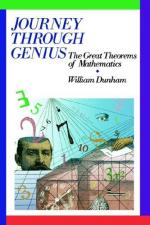
|
| Name: _________________________ | Period: ___________________ |
This test consists of 5 multiple choice questions, 5 short answer questions, and 10 short essay questions.
Multiple Choice Questions
1. What hindered Euler's work as he grew older?
(a) He had a stroke.
(b) He had very bad arthritis.
(c) His hearing was getting worse.
(d) His increasing blindness.
2. What is true about the successive squared denominator series proposed by the Bernoullis?
(a) The sum diverges into infinity.
(b) The sum converges to 2.
(c) The sum converges.
(d) The sum diverges.
3. How did Gauss feel about his best work?
(a) He was confident that his students would find it of great importance.
(b) He was unceratin if it would be accepted by his collegues.
(c) He was confident that it would change mathematics.
(d) He was uncertain if it was useful.
4. What did Cantor develop?
(a) A system to identify prime numbers of very large size.
(b) A method to find the sum of a geometric series.
(c) A method to factor very large composite numbers.
(d) A system to compare relative sizes of cardinal numbers.
5. What was described as true about the series 1 + 1/2 + 1/6 + 1/10 + 1/15 + 1/21?
(a) It's a convergent series of triangular numbers.
(b) It's a divergent series with a sum of 2.
(c) It's a divergent series squared numbers.
(d) It's a convergent series of cubic numbers.
Short Answer Questions
1. What did Cantor define as the continuum?
2. Which of the following is a series that the Bernoullis proposed did not converge on a finite sum?
3. How did Euler prove if the number 4,294,967,297 was prime or composite?
4. Which phrase best describes Newton as a student at Cambridge?
5. In what area was Gauss especially interested?
Short Essay Questions
1. Describe Cantor's difficult personal life.
2. What great theorems and work of Newton did Dunham highlight?
3. Give an example of a series who's sum is still unknown.
4. Describe the controversy that Newton was caught in with his publication of his calculus methods.
5. Why did Euler start working on the sum of series?
6. Who was Georg Cantor, and what was significant about his work in mathematics?
7. Summarize in a few sentences, what types of number sets did Cantor prove to be denumerable and non-denumerable.
8. Describe Newton's days in Cambridge and what he eventually came to discover.
9. Describe some of the characteristics of Leonhard Euler, and what made him successful.
10. Explain what was the definition of a series before the Bernoullis, and give examples of what was known.
|
This section contains 801 words (approx. 3 pages at 300 words per page) |

|




